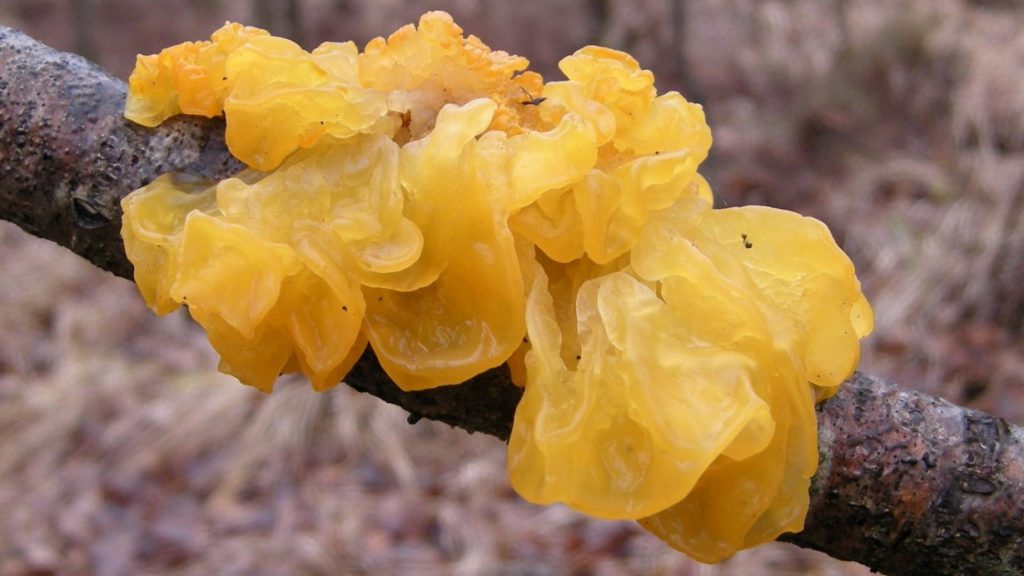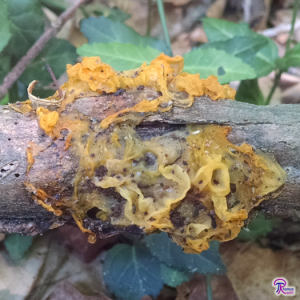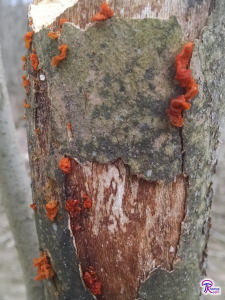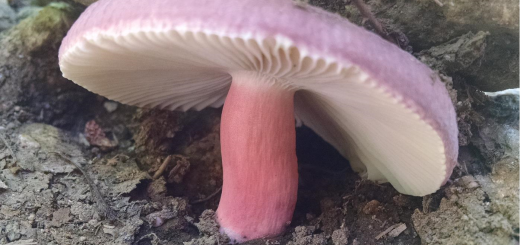#059 Tremella mesenterica, Witch’s Butter

Tremella mesenterica is known as “Witch’s Butter” because it is the color of butter and because it was supposedly used by witches to place hexes on people. Photo by Jplm [GFDL or CC BY-SA 3.0], via Wikimedia Commons (cropped).
Morphology
Tremella mesenterica usually goes by the common name “Witch’s Butter,” but some people know it as “Yellow Brain Fungus.” The scientific name Tremella mesenterica translates to “trembling middle intestines.” From these descriptive names you can probably get an idea of what Witch’s Butter looks like: a yellow, squishy, lobed, wavy, and otherwise irregular blob.2,3
When fully hydrated, Witch’s Butter is 2-10cm across and 3-4cm tall. It is composed of a network of rounded gelatinous lobes that connect with each other unpredictably. Even when compared with other jelly fungi, T. mesenterica is insubstantial. Its lobes do not tear easily, but they easily bend when the smallest force is applied. Consequently, the mushrooms are very droopy and usually look half melted. It is bright yellow to pale yellow, often fading when very wet. There is also a pure white form of T. mesenterica, but it is rarely seen. The mushroom gets much smaller as it dries out, becoming a tough thin orange-yellow slightly bumpy streak on its substrate.2–4
Under the microscope, T. mesenterica is interesting because it has “cruciate septate basidia.” Unlike in most basidiomycete mushrooms, the basidia of jelly fungi are split into four separate cells by septa. In T. mesenterica and its relatives in the order Tremellales, the septa are arranged vertically. When you look at them from the side, the basidia appear to be divided in half by a single septum. From above, however, you can see that there are actually two septa that cross in the middle to form a “+” shape. This arrangement gives cruciate septate basidia their name. Each section of the basidium produces a long sterigma, which bears a single spore (the basidium therefore produces four spores in total). [See Tom Volk’s page for pictures of the basidia.]1
Ecology
T. mesenterica is a common jelly fungus that is found fruiting from dead hardwood. The species is widely distributed in temperate areas across the globe. Because of its gelatinous nature, it is most often seen during wet weather (at any time of the year) when it is fully expanded.2–4 The gelatinous texture allows the fruiting body to quickly expand and produce spores in wet weather while easily shriveling up to protect itself during long, dry periods.2
Although it fruits from dead wood, Witch’s Butter does not decompose wood. Instead, it parasitizes wood-decomposing fungi, as do the other fungi in the order Tremellales.1,3,4 T. mesenterica attacks crust fungi in the genus Peniophora. Despite this, you rarely find fruiting bodies of the host fungus alongside Witch’s Butter.3,4
T. mesenterica shares one more unusual characteristic with its relatives: it has a yeast phase. In the absence of its host, the fungus tends to grow as individual yeast cells rather than as connected hyphae. For the most part, this is significant only for mycologists who are trying to grow the fungus in the lab. Even experienced mycologists can mistakenly toss out the yeast, mistaking it for a contaminant. If they do remember to keep the yeast, it still doesn’t survive very long without a suitable host.1
Similar Species
T. mesenterica is not the only yellow gelatinous fungus that appears on logs. In fact, there is one closely related species that is indistinguishable from T. mesenterica without microscopic analysis: T. aurantia. That fungus is parasitic on the crust fungus Stereum hirsutum, which also grows on hardwoods. Unless you find the fruiting bodies of the host, you can’t be sure which species you’ve found. Microscopically, T. aurantia has smaller spores, smaller basidia with stalks, and lacks vesicles. If you don’t have access to a microscope to check those characteristics, just call what you’ve found Witch’s Butter, since that common name is used for both mushrooms.1,3,5
The jelly fungus Dacrymyces palmatus is also very similar and looks like a smaller version of T. mesenterica at first glance. However, closer inspection usually reveals minute differences. Assessing the type of wood is very useful for differentiating between the two species, since D. palmatus grows only on conifer wood. Another feature to check is the point of attachment; D. palmatus is tough and white where it connects to its substrate.2,4,5 If you’re still not sure, look at the mushroom’s basidia under the microscope. D. palmatus can be readily distinguished by its Y-shaped “tuning fork basidia.”4,5

Witch’s Butter gets funky when old. Its lobes become even more irregular and its colors fade so that it looks more like a slime mold than a fungus.
Edibility
There does not seem to be consensus about whether or not Witch’s Butter is edible. T. mesenterica is nonpoisonous, so it’s really up to the individual to decide if the flavorless fungus is worth eating.2,3 To me, it seems a little less substantial than other edible jelly fungi, so I don’t bother collecting it. Like the Jelly Ear (Auricularia auricula, FFF#134) and the Snow Fungus (Tremella fuciformis, FFF#023), Witch’s Butter would be eaten for its texture and not its taste.
Taxonomy
T. mesenterica was described in 1769 as the type species for the genus Tremella.3 In other words, Witch’s Butter is what mycologists think of when they hear “Tremella.” Because of this, expect the fungus to remain in Tremella throughout the genetics era.
| Kingdom | Fungi |
| Division (Phylum) | Basidiomycota |
| Subdivision (Subphylum) | Agaricomycotina |
| Class | Tremellomycetes |
| Subclass | Tremellomycetidae |
| Order | Tremellales |
| Family | Tremellaceae |
| Genus | Tremella |
| Species | Tremella mesenterica (Schaeff.) Retz6 |
This post does not contain enough information to positively identify any mushroom. When collecting for the table, always use a local field guide to identify your mushrooms down to species. If you need a quality, free field guide to North American mushrooms, I recommend Michael Kuo’s MushroomExpert.com. Remember: when in doubt, throw it out!
See Further:
http://botit.botany.wisc.edu/toms_fungi/oct2000.html
http://www.mushroomexpert.com/tremella_mesenterica.html
http://www.messiah.edu/Oakes/fungi_on_wood/jelly%20fungi/species%20pages/Tremella%20mesenterica.htm
Citations
- Volk, T. J. Tom Volk’s Fungus of the Month for October 2000. Tom Volk’s Fungi (2000). Available at: http://botit.botany.wisc.edu/toms_fungi/oct2000.html. (Accessed: 12th October 2017)
- Emberger, G. Tremella mesenterica. Fungi Growing on Wood (2008). Available at: http://www.messiah.edu/Oakes/fungi_on_wood/jelly%20fungi/species%20pages/Tremella%20mesenterica.htm. (Accessed: 12th October 2017)
- O’Reilly, P. Tremella mesenterica Retz. – Yellow Brain Fungus. First Nature Available at: http://www.first-nature.com/fungi/tremella-mesenterica.php. (Accessed: 12th October 2017)
- Kuo, M. Tremella mesenterica: Witch’s Butter. MushroomExpert.Com (2008). Available at: http://www.mushroomexpert.com/tremella_mesenterica.html. (Accessed: 12th October 2017)
- Wood, M. & Stevens, F. California Fungi—Tremella aurantia. The Fungi of California Available at: http://www.mykoweb.com/CAF/species/Tremella_aurantia.html. (Accessed: 12th October 2017)
- Tremella mesenterica. Mycobank Available at: http://www.mycobank.org/BioloMICS.aspx?TableKey=14682616000000067&Rec=104827&Fields=All. (Accessed: 12th October 2017)









![#011: Characteristics of Kingdom Fungi [Archived]](https://www.fungusfactfriday.com/wp-content/themes/hueman/assets/front/img/thumb-small-empty.png)

This looks like a good soup recipe,
https://www.tnp.sg/lifestyle/hed-chef/collagen-boosting-fish-maw-and-wild-yellow-gold-ear-mushroom-soup
I had similar in Asia. Substitute fish maw with anything tasty.